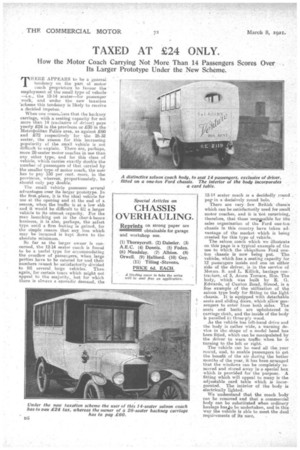TAXED AT £24 ONLY.
Page 10

If you've noticed an error in this article please click here to report it so we can fix it.
How the Motor Coach Carrying Not More Than 14 Passengers Scores Over Its Larger Prototype Under the New Scheme.
• THERE APPEARS to be a general
tendency on the part of motor coach proprietors to favour the employment of the small type of vehicle —i.e., the 12-14 seater—for passenger work, and under the new taxation 'scheme this tendency is likely to receive a decided impetus.
When one reineh:oers that the hackney carriage, with a seating capacity for not snore than 14 (exclusive or driver) pays yearly 224 in the provinces or 230 in the Metropolitan Police area, as against 260 and 272 respectively for • the 26-32 seater, the reason for this increasing popularity of the small vehicle is not difficult to explain. There are, perhaps, more 28-seater motor coaches in use than any other type, and for this class of vehicle, which carries exactly double the number of passengers of that carried by the smaller type of motor coach, the user has to pay 150 per cent, more, in the provinces, whereat, proportionately, he should only pay double.
The small vehicle possesses several advantages over its larger prototype. In the first,place, it is the ideal vehicle for use at the opening and at the end of a season, when the traffic is at a low ebb and it would be difficult to fill a larger vehicle to its utmostcapacity. For the man launching out in the char--banes business, it is also, perhaps, the safest type until a firm footing -is gained, for the simple reason that any loss which may be incurred is kept down to the absolute minimum.
So far as the larger owner is concerned, the. 12-14 seater coach is found to be a useful type for accommodating the overflow of passengers, when large parties have to be catered for and their numbers cannot be satisfactorily divided to fill several large vehicles. Then again; for certain tours which might not appeal to the majority, but for which there is always a sporadic demand, the 12-14 seater coach is a decidedly round , • pegin a decisively round hole:
There are very. few Britishchassis which can be satisfactorily used for small
motor coaches, and it is not surprising, therefore, that those reapirible for the sales organization of the Ford one-ton chassis in this country have taken advantage of the market which is being created for this type of vehicle.
The saloon coach which we illustrate on this page is a typical example of the use to which the ubiquitous Ford one ton chassis is now being put. The vehicle, which has a seating capacity for
12 passengers inside and one on either side of the driver, is in the service of Messrs. S. and L. Killick, haulage contractors, of 3, Acorn Terrace, Hoe. The body, which was built by E. G. Edwards, of Caxton Road, Strood, is fine example of the utilization of the saloon type body for fitting to the light
chassis. lt is equipped with detachable seats and sliding doors, which allow pas
sengers to enter from both sides. The seats and backs are upholstered in carriage cloth, and the inside of the body is panelled in three-ply wood.
As the vehicle has left-hand drive and the body is rather wide, a warning de vice in the.shape of a model hand has been fitted, which can be manipulated by the driver to warn traffic when he is turning to the left or right. The vehicle can be used all the year round, and, to enable passengers to get the benefit of the air during the better months of the year, it has been arranged that the windows can be completely re moved and stored away in a special box which is provided for the 'purpose. A fitting which will appeal to many is the adjustable card table which is incorporated. The interior of the body is electrically lighted.
We understand that the coach body can be removed and that a commercial body can be substituted when ordinary haulage haso be undertaken, and in this way the vehicle is able to meet the daa1 requirements of its user.
































